Dual Wet Re-Entries And Eskimo Recoveries
All-In Recovery Variation
By Wayne Horodowich
The traditional All In Recovery (See USK article, "All-In Recovery") takes some time and a good deal of orchestration and manipulation to complete,
which leaves the 2nd paddler in the water for a longer exposure time. Since
one of your goals for a capsize recovery should be to minimize your exposure
to the elements, here is a variation for getting two or more swimmers back
in their kayaks quickly. Having pumps is a necessity for this variation.
Before I continue, I must admit that my first recommendation for any "All In" situation is every paddler does their quickest solo recovery. Once you are back in your kayak, with you and your boat sea worthy, then you can go help someone else. The "All In" recovery techniques are only good if solo recoveries cannot be performed. Then you need to depend on each other for a recovery. The swim time alone to get the kayaks near each other has more exposure time than I would like, but if solo options are out then swimming kayaks to each other is what needs to be done.
It may be a good idea to review the Eskimo
Bow Recovery and the Eskimo Paddle
Recovery before you continue if you are not familiar with the techniques. See the USK Library Page "Capsize Recoveries" for these and other techniques.
The idea of this "All In" variation is to do a wet re-entry and use you partners kayak
(whether upright or overturned) for support to right yourself. When you come
up you will have water in the cockpits, but the exposure time is relatively
short when using this variation. A note of caution, be careful of banging
kayaks when the seas are challenging. Helmets would be an excellent addition
in rough conditions.
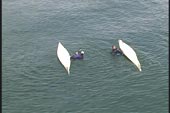 As in any All-In Recovery, the paddlers in the water need
to move their kayaks next to each other. Since most of us paddle some distance
from our partners during an outing, the exposure time is increased just during
the process of moving the kayaks together.
As in any All-In Recovery, the paddlers in the water need
to move their kayaks next to each other. Since most of us paddle some distance
from our partners during an outing, the exposure time is increased just during
the process of moving the kayaks together.
Once the kayaks are together, you and your partner need to
decide if you will do this simultaneously or one at a time. In this example we
will show the technique with one paddler completing the skill before the other one begins.
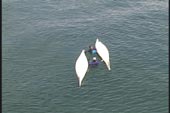 When the kayaks are together and parallel, with the kayaks
in the bow to stern position, you and partner decide who will re-enter first.
The 2nd paddler keeps the kayaks together. They can also hold both of the
paddles.
When the kayaks are together and parallel, with the kayaks
in the bow to stern position, you and partner decide who will re-enter first.
The 2nd paddler keeps the kayaks together. They can also hold both of the
paddles.
Deck lines provide a good hand hold for keeping kayaks together. You will need to release the deck line as your partner rolls up, but at that point they are holding the kayaks together. You can grip another line when your partner is upright.
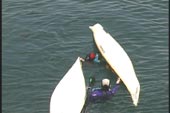 While paddler number two keeps the kayaks together, the first
paddler performs a wet re-entry into their kayak. Remember to get yourself completely
into your kayak with your feet on the foot pegs, thighs under the braces and
your backside onto your seat.
While paddler number two keeps the kayaks together, the first
paddler performs a wet re-entry into their kayak. Remember to get yourself completely
into your kayak with your feet on the foot pegs, thighs under the braces and
your backside onto your seat.
When ready, reach for the overturned bow of your partner's
kayak and use it as a support to right yourself. You will use less energy
if you have your head come up last by using your knees and hips to right your
kayak first and let your body follow.
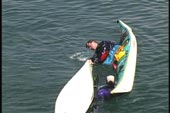 One of the values of having proper floatation in a kayak is the support it can provide. Without good floatation,
the end of the kayak would sink when weight were placed on it. Proper floatation gives you and your partner options.
One of the values of having proper floatation in a kayak is the support it can provide. Without good floatation,
the end of the kayak would sink when weight were placed on it. Proper floatation gives you and your partner options.
Improper floatation not only limits your options it can lead to serious consequences such as losing your kayak.
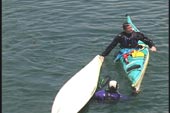 When the first paddler is upright, they will have a cockpit partially
filled with water. Even though this can cause some instability the second kayak
provides the support necessary to stay upright. Since minimizing exposure
time is essential, it is more important to get the second paddler out of the water
before pumping out the water. As you will see later, pumping is better off
done at the end of the entire sequence.
When the first paddler is upright, they will have a cockpit partially
filled with water. Even though this can cause some instability the second kayak
provides the support necessary to stay upright. Since minimizing exposure
time is essential, it is more important to get the second paddler out of the water
before pumping out the water. As you will see later, pumping is better off
done at the end of the entire sequence.
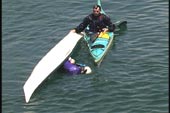 After the paddles are transferred to the first paddler, who
is now upright and holding the other kayak, the second paddler can begin
their wet re-entry. When they are seated properly in their cockpit (upside-down)
they reach for the upright bow of their partner's kayak. Again, be careful
in rough seas.
After the paddles are transferred to the first paddler, who
is now upright and holding the other kayak, the second paddler can begin
their wet re-entry. When they are seated properly in their cockpit (upside-down)
they reach for the upright bow of their partner's kayak. Again, be careful
in rough seas.
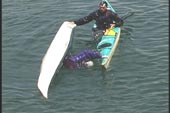 The second paddler rights his or her self, using efficient righting
techniques. Grabbing the bow is only one of a few variations. The second paddler
could have kept their paddle and once in their kayak use the paddle as a bridge
between the kayaks and roll upright.
The second paddler rights his or her self, using efficient righting
techniques. Grabbing the bow is only one of a few variations. The second paddler
could have kept their paddle and once in their kayak use the paddle as a bridge
between the kayaks and roll upright.
The first paddler could have used the Eskimo Paddle Recovery
for the second paddler as another variation.
If the second paddler didn't want to do a wet re-entry the
first paddler could perform a standard T-Recovery or any number of assisted recoveries. See the USK Library Page "Capsize Recoveries" for these and other techniques.
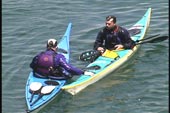 When the second paddler is upright, they can get their paddles
back while each maintains an upright position (remember there is water in
their cockpits) by getting support from each other's kayak. Using paddle
bridges across both boats gives great support.
When the second paddler is upright, they can get their paddles
back while each maintains an upright position (remember there is water in
their cockpits) by getting support from each other's kayak. Using paddle
bridges across both boats gives great support.
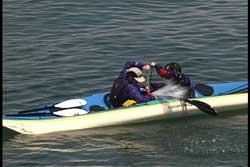 To get the water out of their kayaks, the two paddlers need
to rest on each other's kayak and pump out the other's cockpit. By edging
the kayaks toward each other the water pools toward the inside where it is
very easy to pump the water.
To get the water out of their kayaks, the two paddlers need
to rest on each other's kayak and pump out the other's cockpit. By edging
the kayaks toward each other the water pools toward the inside where it is
very easy to pump the water.
Resting on each other's kayak allows both to pump at the same
time while getting support. When done both kayakers can be on their way.
I mentioned earlier a pump was needed to do this recovery technique.
While a pump will make it easier, there is still a way to empty the water
after the dual wet re-entry. Have you figured out how to do it? I am not
talking about a bailing bucket or a sponge. Has a method come to you yet?
There is a way to get the water out of both kayaks, but it will take some
work. See USK "Skill of the Month", April 2002 for a possible solution.
I also mentioned that both swimmers could do their wet re-entry
and Eskimo Recovery simultaneously. They would each keep their paddles between
the kayaks and retrieve them when upright. It takes some practice to do it
at the same time, but it does work. The key is to support yourself on your partner's kayak while allowing the kayak to roll under your hands.
This can also be done simultaneously, if both paddlers used a paddle bridge to roll up as done in the Eskimo Paddle Recovery. Since the kayaks are rolling under the paddles, there would be little resistance from the other paddler.
If your partner were to let go of your kayak during your wet
re-entry phase what would you do? Would you wet exit and try again? Remember,
you want to minimize overall exposure time and starting again will take longer.
There are a few possibilities that come to mind for me. What comes to your
mind? See USK "Skill of the Month", April 2002 for your answer.
As you can see there are a number of ways to get the job done.
The Dual Wet Re-entry and Eskimo Recovery is a wonderful variation to the
traditional All-In Recovery. As always, I recommend you use nose clips* when
performing any wet re-entry. It not only increases most paddlers breath holding
capacity, it also reduces the chance of infection due to contaminated water
in your nose and sinuses.
*User friendly "Tweaker" nose clips are now available
at the USK Store.
USK Home
Page
Pictures seen above were taken from the USK Video "Capsize
Recoveries & Rescue Procedures"
© Copyright USK
 As in any All-In Recovery, the paddlers in the water need
to move their kayaks next to each other. Since most of us paddle some distance
from our partners during an outing, the exposure time is increased just during
the process of moving the kayaks together.
As in any All-In Recovery, the paddlers in the water need
to move their kayaks next to each other. Since most of us paddle some distance
from our partners during an outing, the exposure time is increased just during
the process of moving the kayaks together. When the kayaks are together and parallel, with the kayaks
in the bow to stern position, you and partner decide who will re-enter first.
The 2nd paddler keeps the kayaks together. They can also hold both of the
paddles.
When the kayaks are together and parallel, with the kayaks
in the bow to stern position, you and partner decide who will re-enter first.
The 2nd paddler keeps the kayaks together. They can also hold both of the
paddles. While paddler number two keeps the kayaks together, the first
paddler performs a wet re-entry into their kayak. Remember to get yourself completely
into your kayak with your feet on the foot pegs, thighs under the braces and
your backside onto your seat.
While paddler number two keeps the kayaks together, the first
paddler performs a wet re-entry into their kayak. Remember to get yourself completely
into your kayak with your feet on the foot pegs, thighs under the braces and
your backside onto your seat. One of the values of having proper floatation in a kayak is the support it can provide. Without good floatation,
the end of the kayak would sink when weight were placed on it. Proper floatation gives you and your partner options.
One of the values of having proper floatation in a kayak is the support it can provide. Without good floatation,
the end of the kayak would sink when weight were placed on it. Proper floatation gives you and your partner options. When the first paddler is upright, they will have a cockpit partially
filled with water. Even though this can cause some instability the second kayak
provides the support necessary to stay upright. Since minimizing exposure
time is essential, it is more important to get the second paddler out of the water
before pumping out the water. As you will see later, pumping is better off
done at the end of the entire sequence.
When the first paddler is upright, they will have a cockpit partially
filled with water. Even though this can cause some instability the second kayak
provides the support necessary to stay upright. Since minimizing exposure
time is essential, it is more important to get the second paddler out of the water
before pumping out the water. As you will see later, pumping is better off
done at the end of the entire sequence. After the paddles are transferred to the first paddler, who
is now upright and holding the other kayak, the second paddler can begin
their wet re-entry. When they are seated properly in their cockpit (upside-down)
they reach for the upright bow of their partner's kayak. Again, be careful
in rough seas.
After the paddles are transferred to the first paddler, who
is now upright and holding the other kayak, the second paddler can begin
their wet re-entry. When they are seated properly in their cockpit (upside-down)
they reach for the upright bow of their partner's kayak. Again, be careful
in rough seas. The second paddler rights his or her self, using efficient righting
techniques. Grabbing the bow is only one of a few variations. The second paddler
could have kept their paddle and once in their kayak use the paddle as a bridge
between the kayaks and roll upright.
The second paddler rights his or her self, using efficient righting
techniques. Grabbing the bow is only one of a few variations. The second paddler
could have kept their paddle and once in their kayak use the paddle as a bridge
between the kayaks and roll upright.  When the second paddler is upright, they can get their paddles
back while each maintains an upright position (remember there is water in
their cockpits) by getting support from each other's kayak. Using paddle
bridges across both boats gives great support.
When the second paddler is upright, they can get their paddles
back while each maintains an upright position (remember there is water in
their cockpits) by getting support from each other's kayak. Using paddle
bridges across both boats gives great support.  To get the water out of their kayaks, the two paddlers need
to rest on each other's kayak and pump out the other's cockpit. By edging
the kayaks toward each other the water pools toward the inside where it is
very easy to pump the water.
To get the water out of their kayaks, the two paddlers need
to rest on each other's kayak and pump out the other's cockpit. By edging
the kayaks toward each other the water pools toward the inside where it is
very easy to pump the water.